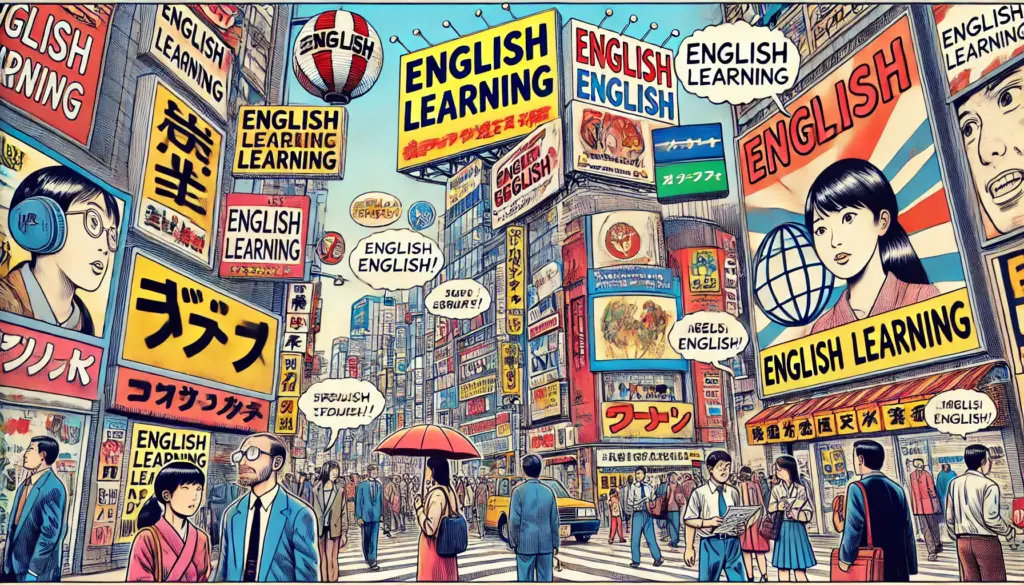
If you’ve walked through any major Japanese city, you’ve likely seen countless ads for English learning—on subways, billboards, and buildings. The overwhelming presence of these ads naturally raises a question: how much are Japanese people actually spending on learning English? And just how big is the English education industry in Japan?
Let’s take a closer look.
🇯🇵 The Scale of Japan’s English-Learning Industry
Japan’s English-learning industry is one of the largest in the world. It includes:
- English conversation schools
- Study materials (textbooks, apps, e-learning)
- Online English tutors
- Tests like TOEIC and Eiken
- Study-abroad programs
- Translation and interpretation services
The combined size of these sectors is estimated to be close to ¥800 billion annually. When you include related services such as publishing, testing, and travel support, the industry’s total scale becomes even larger.
The demand has stayed strong despite economic ups and downs. Recently, there’s been a shift from physical classrooms to online platforms, which has helped reduce costs for some learners while increasing access for others.
💸 How Much Does the Average Person Spend?
The answer depends greatly on the learner’s stage in life:
🧒 Children & Teenagers
- Many students attend cram schools or English conversation classes.
- Over six years, families can spend between ¥500,000 to ¥1,000,000 just on private English education.
- If children attend international schools, annual tuition alone can be ¥2 to ¥3 million, not including other costs.
🎓 University Students
- Those who major in English or prepare for overseas study often invest in:
- Specialized prep courses
- Study-abroad programs
- Certification tests
- Total expenses can easily exceed ¥1 million over the course of university life.
👩💼 Working Adults
- Professionals often take online English conversation lessons, which range from ¥5,000 to ¥20,000 per month.
- Some enroll in business English courses or test preparation classes, which can cost tens of thousands of yen per course.
- Over a year, many serious learners spend ¥100,000 to ¥300,000—though it varies depending on motivation, income, and goals.
🏙️ Why Are There So Many Ads?
There are several reasons why English-learning ads are everywhere in Japan:
- Persistent Social Pressure
English proficiency is still viewed as a status symbol and a career advantage. Even those who don’t use it daily feel that they “should” learn it. - Massive Target Market
Everyone from preschoolers to retirees is considered a potential customer. This wide demographic allows companies to invest heavily in marketing. - Rebound After the Pandemic
Interest in travel, study abroad, and international business has surged again. This has pushed companies to advertise more aggressively. - Government Incentives
Some language courses are now eligible for public support or job-training subsidies, making it easier for people to invest in English education.
🧠 Why People Are Willing to Spend
Here are a few psychological and cultural factors that fuel spending:
- Fear of falling behind: People worry about being at a disadvantage in the job market.
- Hope for transformation: Many believe that speaking English can change their lives, careers, or identities.
- Desire for global connection: Japan remains relatively isolated linguistically; English feels like a gateway to the world.
💡 A Personal Reflection
From my point of view, English education in Japan is not just a consumer trend—it’s a cultural phenomenon. People aren’t just learning a language. They’re buying access to confidence, opportunity, and social mobility.
But there’s also a shift happening. More learners are realizing that they don’t need to spend a fortune to become fluent. Online tools, free content, and language exchange platforms are giving more people a chance to learn affordably.
That said, whether you’re spending ¥500 a month or ¥500,000 a year, what really matters is consistency and motivation. The flashy subway ads may catch your eye—but the real progress happens quietly, one lesson at a time.



















































